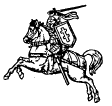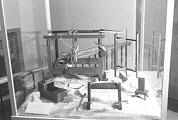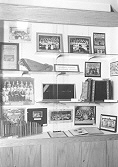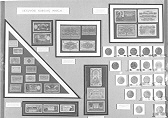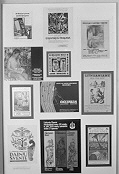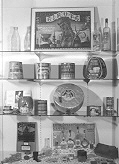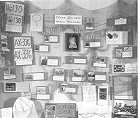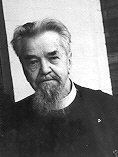
LITHUANIAN MUSEUM
The Lithuanian Museum opened to the public on April 23, 1989.
Among the exhibits:
Lithuanian Loom. Miniature working model of a
Lithuanian weaving loom rebuilt by Father John Duoba,
MIC. Some of the parts include the siaudykle (shuttle),
seiva (bobbin), nytys (heddles), skietas (reed),
mintuvai (brake), and karstuvai (carder). Also included
in the exhibit is a measure of cloth, hand woven in
Lithuania in 1851 by an unknown weaver from the
Siauliu district.
Agriculture, Manufacturing, and Commerce. The exhibit
features agricultural models built and donated by Marija and
Stasys Kontrimas. The model implements include a pluga (plow),
akecios (harrow), sulinys (well), arklas (wooden plough), volas
(roller), and a working model of a linamine (flax-breaker). Also
included are antique postcards depicting farming scenes. The
commerce and manufacturing exhibit features a unique
collection of items features at the Lithuanian Pavilion of the
1939 New York World's Fair. Note the canned food products
and cheese which were for export to the United States. Also
note other manufactured goods of pre-war Lithuania - soaps,
matches, playing cards, spirits, even the original label drawing for Birute Sparkling
Mineral Water drawn by the famous artist M. Dobuzinskis.
Elena Juciute - Partizan and Siberian Exile. This exhibit is
dedicated to all Lithuanians who have been unjustly deported
to Siberia. Elena Juciute, now deceased, was deported for
15 years for her anti-communist activities. On her release,
Juciute managed to bring out an astonoshing suitcase full of
material related to her years in exile. Exhibited you will find
examples of her crocheting, crafted using a matchstick, hand
made bread dough rosary, intricate wood inlay pictures,
mica-Ieaf booklet, photographs, prisoner identification
numbers worn front and back. All exhibit labels are in Juciutes own handwriting.
Lithuanian Church Banners. Elaborate banners were widely used in Lithuanian
Catholic churches. Two examples from the LRSC collection are displayed. The first
banner is from the "Friendship of St. M.P. Rosary Bachelorettes and Women"
Society, which was instituted April 16, 1905. The second banner is the "Society of St.
Casimir the Prince's Brotherly Aide" instituted May 17, 1914. The elaborate
embroidery and painting on cloth is a tribute to the artful craftsmanship of many an
anonymous Lithuanian lady of the past.
Lithuanian Music. Among the materials of the Zilevicius -
Kreivenas Lithuanian Musicology Archives exhibited are an
"armonika" - an accordion-like instrument manufactured in Tilze,
Lithuania in the 1890's; "skuduciai" - folk wind-pipe instruments,
and the baton used by past Lithuanian Song Festival conductors.
Vydunas. The Vydunas Youth Fund organized the exhibit of one
of the foremost Lithuanian philosophers, Vilius Storosta-Vydunas.
Exhibited are the Vydunas death mask, his pen and inkwell, his
father's watch, his tuning fork, J. Pautienius' oil portrait, a
selection of photographs, and a rare complete collection of
Vydunas' works. A reading of Vydunas' works are as applicable today as they were
during Lithuania's independence 70 years ago.
Lithuanian Military. The exhibit includes numerous military identification papers,
insignia, numerous ribbons and medals, and photographs. Also exhibited is a
Lithuanian Army officer's uniform and coat; the Lithuanian American first battalion
cap which was to be used in an aborted attempt by American soldiers to defend
Lithuania; Prof. Dr. Kazys Pakstas' medals; and prof. Augustinas Voldemaras' signed
enlisted soldier's diploma. The Lithuanian World Archives collection contains
numerous military items. The LRSC military collection consultants are Vytenis
Statkus and Henry Gaidis.
M.K. Ciurlionis. One of Lithuania's most famous and talented artists and
composers is represented with an extremely rare example of Ciurlionis' variation of
the music for the Lithuanian national anthem written in his own hand. Many other
Ciurlionis items are contained in the collections of the Lithuanian Archive of
Musicology.
Religion in Lithuania. A unique Lithuanian form of hand-carved folk art can be
found in the cross and monstrance created by Jurgis Pocius, in Pennsylvania in
1886. The intricate pieces are fitted together entirely without glue or nails. The
carved statue of Christ hails from Akmenes parish in Lithuania and is over 100 years
old. A hand carved wooden rosary dates back to 1810. The Marian Fathers have
lent the St. Casimir and the St. George slaying the dragon wooden statues which are
over 200 years old and once graced wayside crosses in Lithuania. A number of rare
prayer books and bibles from the Lithuanian World Archives collection are exhibited,
including the 1816 Bishop Merkelis Giedraitis bible. Along the top of the display is a
photo panorama of Vilnius, Lithuania, circa 1938.
Lithuanian Wayside Crosses. These hand-wrought iron crosses were originally
used at the very tops of wooden wayside crosses in Lithuania and date from the
middle of the 19th century and until 1989 were housed at the Marian Fathers Library
in Connec- ticut. Also exhibited is a rare copy of artist Adomas Varnas' photo album
of Lithuanian wayside crosses.
Lithuanian Rare Books. From the collection of over 113,000 volumes of books and
over 2,200 periodical titles contained in the Lithuanian World Archives, we show
various rare books, published in Lithuania, Prussia, and the United States during the
19th century. Note, also, the extremely rare copy of the Lithuanian Statutes,
published in 1786.
Lithuanian Museum of Medicine. Exhibits include an outstanding collection of
various instruments, diplomas, and personal items associated with famous
Lithuanian doctors. Also exhibited are pharmaceuticals of Lithuanian manufacture,
antique dental equipment, the Red Cross flag of former radio personality Sophie
Barcus, personal items of former Lithuanian president Dr. Kazys Grinius, even the
keys and seal of the Vytautas the Great University Medical Faculty. Also housed is
an extensive collection of Lithuanian medical literature.
Rare Lithuanian Folk Art Prints. Seven extremely rare wood cuts were acquired
by the LRSC in 1989. They are printed on rag paper and overprinted in various
colors. The oldest is dated 1710 and is the oldest known Lithuanian wood-cut. The
graphic arts examples include St. Casimir, Mariazelis Madona, St. Anne, Adam and
Eve, The Last Judgement, St. George, and The Pieta. The graphic arts collection is
co-administered by the LRSC together with the Lithuanian Institute for Fine Arts.
Artist Pranas Domsaitis. Lithuanian artist Pranas Domsaitis worked in Prussia,
Germany and South Africa. He participated in many shows of his works, including
some with the great Marc Chagall. The Lithuanian Institute for Fine Arts has a full
collection of his works. Other artists represented in the Lithuanian Institute for Fine
Arts collection include the works of Viktoras Petravicius and M. Dobuzinskis. Also
housed at the Institute are the complete art archives of the late Casimir Baltramaitis.
Lithuanian Posters. The Lithuanian World Archives contain
a large collection of posters which touch on the social and
political lives of Lithuanians, especially in the United States.
Many are very old and rare. A representative selection displayed
points out the active life of BALF, Lithuanian Opera, Lithuanian
World Youth Congress, Dainava Ensemble, Lithuanian American
Community Cultural Congress and many others.
Lithuanian Photographs. A representative collection of
photographs housed at the Budrys Lithuanian Photo Archives
is displayed. The photos, in their original frames, include those
of the Margutis radio program, Alice Stephens choir, Ausra DP
Ensemble, Cleveland Lithuanian Chorus, St. George's Lithuanian parish school
orchestra, Lithuanian consul general Petras Dauzvardis, and many others.
Monsignor Mykolas Krupavicius. The famous clergyman and
diplomat Mykolas Krupavicius was active in
the Lithuanian political arena for over fifty
years. Displayed are items related to his
religious, diplomatic, and personal life, for
instance his chalice and cross, diplomatic
passports, documents attesting to his
ascendancy to monsignor signed by
Giovanni Baptista Montini, who later
became Pope Paul VI, the cup used by
Krupavicius when he was a Nazi prisoner,
even his hat, cane.
Commemorative Envelopes. The Lithuanian Philatelic Society "Lietuva" presents
a selection of various envelopes issued to commemorate important events in
Lithuanian life.
Lithuanian Currency and Coins. The collection of
currency and coins includes those minted in Lithuania
during its prewar period of freedom, as well as money
that was used during czarist times and Nazi and Soviet
occupations. The collection was assembled by
Dr. J. Rackauskas and Rev. Vaclovas Gutauskas, S.J.
Lithuanian Stamps. The Lithuanian stamps represent part of the collection of the
Lithuanian Philatelic Society "Lietuva". The collection is arranged thematically and so
presents the history of Lithuania. Note the rare stamp issues of Grand Duke
Vytautas, the Lithuanian presidents, Maironis, Basanavicius, Darius and Girenas,
the artist Varnas, and many others. The collection project was completed by the
founder of the Lithuanian Philatelic Society, Ignas Sakalas.
President Aleksandras Stulginskis. Signer of Lithuania's declaration of
independence, president of Lithuania's Constituent Assembly, second and youngest
president of the Republic (1920-1926), and Siberian exile. The biography of
Stulginskis represents that all too brief golden period of independence for Lithuania
from the inception of the Republic in 1918 to the Soviet occupation in 1940. The
items exhibited include personal letters and official documents, photographs,
including the only known one from his years in Siberia, even his last letter written the
day before his death. This collection was donated by the president's daughter Dr.
Aldona Juozevicius.
Varpas 1889-1906. The political, literary, and educational newspaper “Varpas" was
founded by Dr. Vincas Kudirka as an underground publication during the period of
the czarist ban on publication in the Lithuanian language. It was published in Tilsit
and Ragaine, Prussia, and distributed via the famous "knygnesiai" underground
book carriers' network. Almost 450 writers contributed to "Varpas” (The Bell).
Exhibited are the extremely rare original first six years of issues from 1889-1894.
Lithuanian Organization Insignia. Here we find displayed a variety of
commemoratives issued by numerous Lithuanian organizations active in the United
States between 1900 and 1950. The Lithuanian World Archives collection
demonstrates the active presence of Lithuanian-Americans in the political, social and
religious sphere through groups such as the Knights of Lithuania and the Lithuanian
American Roman Catholic Federation. Note also the buttons issued to commemorate
the visit of the now Blessed Jurgis Matulaitis, to aid the transatlantic flight of Darius
and Girenas, and to wear proudly as a contributor to the Lithuanian Foundation.
Lithuanian Parish Organization Ribbons. The ornate antique ribbons represent
the earliest community life of Lithuanian-Americans which centered around the
parish. The collection represents the period 1888 to 1915 and includes the areas of
West Pullman, Illinois, Baltimore, Chicago and the Pennsylvania settlements. The
ribbons have two sides with an ornate clasp, the black side being used to indicate
mourning. The oldest ribbon is from 1888 and represents the Shenandoah,
Pennsylvania "Society of Brotherly Aid of Saints Peter and Paul".
Kazys Bartasius. Master weaver Kazys Bartasius represents the epitome of the
traditional Lithuanian art of weaving. The complete collection, which was donated to
the Lithuanian Research and Studies Center by Mr. and Mrs. Bartasius in 1988,
represents fifty years of weaving art on his unique looms. A small sample of his work
in traditional sashes, runners, placemats and decorative calligraphy are exhibited.
His woven bookmarks were available through the Library of Congress Folk Art
collection and an issue of "American Folk Life Center News," among other
publications, was devoted to his life and work.
Lithuanian Folk Costume. A folk costume from the Kapsai region of Lithuania
represents our traditional folk art form. Each region in Lithuania developed its own
variations of the lovely costume and, of course, each weaver added her own unique
signature so that no two were exactly alike. The costume exhibited was purchased by
artist Magdalena Stankunas at the "Marginiai" store in Kaunas in 1941 and the
blouse and crown were made in England after the war. The display is decorated with
a folk art style ceramic vase and small table by Adomas Vaitkevicius and the complex
traditional "verba" of Vilnius which were carried to mass on Palm Sunday and
decorated the Easter table.
TOP
The Lithuanian Museum opened to the public on April 23, 1989.
Among the exhibits:
Lithuanian Loom. Miniature working model of a
Lithuanian weaving loom rebuilt by Father John Duoba,
MIC. Some of the parts include the siaudykle (shuttle),
seiva (bobbin), nytys (heddles), skietas (reed),
mintuvai (brake), and karstuvai (carder). Also included
in the exhibit is a measure of cloth, hand woven in
Lithuania in 1851 by an unknown weaver from the
Siauliu district.
Agriculture, Manufacturing, and Commerce. The exhibit
features agricultural models built and donated by Marija and
Stasys Kontrimas. The model implements include a pluga (plow),
akecios (harrow), sulinys (well), arklas (wooden plough), volas
(roller), and a working model of a linamine (flax-breaker). Also
included are antique postcards depicting farming scenes. The
commerce and manufacturing exhibit features a unique
collection of items features at the Lithuanian Pavilion of the
1939 New York World's Fair. Note the canned food products
and cheese which were for export to the United States. Also
note other manufactured goods of pre-war Lithuania - soaps,
matches, playing cards, spirits, even the original label drawing for Birute Sparkling
Mineral Water drawn by the famous artist M. Dobuzinskis.
Elena Juciute - Partizan and Siberian Exile. This exhibit is
dedicated to all Lithuanians who have been unjustly deported
to Siberia. Elena Juciute, now deceased, was deported for
15 years for her anti-communist activities. On her release,
Juciute managed to bring out an astonoshing suitcase full of
material related to her years in exile. Exhibited you will find
examples of her crocheting, crafted using a matchstick, hand
made bread dough rosary, intricate wood inlay pictures,
mica-Ieaf booklet, photographs, prisoner identification
numbers worn front and back. All exhibit labels are in Juciutes own handwriting.
Lithuanian Church Banners. Elaborate banners were widely used in Lithuanian
Catholic churches. Two examples from the LRSC collection are displayed. The first
banner is from the "Friendship of St. M.P. Rosary Bachelorettes and Women"
Society, which was instituted April 16, 1905. The second banner is the "Society of St.
Casimir the Prince's Brotherly Aide" instituted May 17, 1914. The elaborate
embroidery and painting on cloth is a tribute to the artful craftsmanship of many an
anonymous Lithuanian lady of the past.
Lithuanian Music. Among the materials of the Zilevicius -
Kreivenas Lithuanian Musicology Archives exhibited are an
"armonika" - an accordion-like instrument manufactured in Tilze,
Lithuania in the 1890's; "skuduciai" - folk wind-pipe instruments,
and the baton used by past Lithuanian Song Festival conductors.
Vydunas. The Vydunas Youth Fund organized the exhibit of one
of the foremost Lithuanian philosophers, Vilius Storosta-Vydunas.
Exhibited are the Vydunas death mask, his pen and inkwell, his
father's watch, his tuning fork, J. Pautienius' oil portrait, a
selection of photographs, and a rare complete collection of
Vydunas' works. A reading of Vydunas' works are as applicable today as they were
during Lithuania's independence 70 years ago.
Lithuanian Military. The exhibit includes numerous military identification papers,
insignia, numerous ribbons and medals, and photographs. Also exhibited is a
Lithuanian Army officer's uniform and coat; the Lithuanian American first battalion
cap which was to be used in an aborted attempt by American soldiers to defend
Lithuania; Prof. Dr. Kazys Pakstas' medals; and prof. Augustinas Voldemaras' signed
enlisted soldier's diploma. The Lithuanian World Archives collection contains
numerous military items. The LRSC military collection consultants are Vytenis
Statkus and Henry Gaidis.
M.K. Ciurlionis. One of Lithuania's most famous and talented artists and
composers is represented with an extremely rare example of Ciurlionis' variation of
the music for the Lithuanian national anthem written in his own hand. Many other
Ciurlionis items are contained in the collections of the Lithuanian Archive of
Musicology.
Religion in Lithuania. A unique Lithuanian form of hand-carved folk art can be
found in the cross and monstrance created by Jurgis Pocius, in Pennsylvania in
1886. The intricate pieces are fitted together entirely without glue or nails. The
carved statue of Christ hails from Akmenes parish in Lithuania and is over 100 years
old. A hand carved wooden rosary dates back to 1810. The Marian Fathers have
lent the St. Casimir and the St. George slaying the dragon wooden statues which are
over 200 years old and once graced wayside crosses in Lithuania. A number of rare
prayer books and bibles from the Lithuanian World Archives collection are exhibited,
including the 1816 Bishop Merkelis Giedraitis bible. Along the top of the display is a
photo panorama of Vilnius, Lithuania, circa 1938.
Lithuanian Wayside Crosses. These hand-wrought iron crosses were originally
used at the very tops of wooden wayside crosses in Lithuania and date from the
middle of the 19th century and until 1989 were housed at the Marian Fathers Library
in Connec- ticut. Also exhibited is a rare copy of artist Adomas Varnas' photo album
of Lithuanian wayside crosses.
Lithuanian Rare Books. From the collection of over 113,000 volumes of books and
over 2,200 periodical titles contained in the Lithuanian World Archives, we show
various rare books, published in Lithuania, Prussia, and the United States during the
19th century. Note, also, the extremely rare copy of the Lithuanian Statutes,
published in 1786.
Lithuanian Museum of Medicine. Exhibits include an outstanding collection of
various instruments, diplomas, and personal items associated with famous
Lithuanian doctors. Also exhibited are pharmaceuticals of Lithuanian manufacture,
antique dental equipment, the Red Cross flag of former radio personality Sophie
Barcus, personal items of former Lithuanian president Dr. Kazys Grinius, even the
keys and seal of the Vytautas the Great University Medical Faculty. Also housed is
an extensive collection of Lithuanian medical literature.
Rare Lithuanian Folk Art Prints. Seven extremely rare wood cuts were acquired
by the LRSC in 1989. They are printed on rag paper and overprinted in various
colors. The oldest is dated 1710 and is the oldest known Lithuanian wood-cut. The
graphic arts examples include St. Casimir, Mariazelis Madona, St. Anne, Adam and
Eve, The Last Judgement, St. George, and The Pieta. The graphic arts collection is
co-administered by the LRSC together with the Lithuanian Institute for Fine Arts.
Artist Pranas Domsaitis. Lithuanian artist Pranas Domsaitis worked in Prussia,
Germany and South Africa. He participated in many shows of his works, including
some with the great Marc Chagall. The Lithuanian Institute for Fine Arts has a full
collection of his works. Other artists represented in the Lithuanian Institute for Fine
Arts collection include the works of Viktoras Petravicius and M. Dobuzinskis. Also
housed at the Institute are the complete art archives of the late Casimir Baltramaitis.
Lithuanian Posters. The Lithuanian World Archives contain
a large collection of posters which touch on the social and
political lives of Lithuanians, especially in the United States.
Many are very old and rare. A representative selection displayed
points out the active life of BALF, Lithuanian Opera, Lithuanian
World Youth Congress, Dainava Ensemble, Lithuanian American
Community Cultural Congress and many others.
Lithuanian Photographs. A representative collection of
photographs housed at the Budrys Lithuanian Photo Archives
is displayed. The photos, in their original frames, include those
of the Margutis radio program, Alice Stephens choir, Ausra DP
Ensemble, Cleveland Lithuanian Chorus, St. George's Lithuanian parish school
orchestra, Lithuanian consul general Petras Dauzvardis, and many others.
Monsignor Mykolas Krupavicius. The famous clergyman and
diplomat Mykolas Krupavicius was active in
the Lithuanian political arena for over fifty
years. Displayed are items related to his
religious, diplomatic, and personal life, for
instance his chalice and cross, diplomatic
passports, documents attesting to his
ascendancy to monsignor signed by
Giovanni Baptista Montini, who later
became Pope Paul VI, the cup used by
Krupavicius when he was a Nazi prisoner,
even his hat, cane.
Commemorative Envelopes. The Lithuanian Philatelic Society "Lietuva" presents
a selection of various envelopes issued to commemorate important events in
Lithuanian life.
Lithuanian Currency and Coins. The collection of
currency and coins includes those minted in Lithuania
during its prewar period of freedom, as well as money
that was used during czarist times and Nazi and Soviet
occupations. The collection was assembled by
Dr. J. Rackauskas and Rev. Vaclovas Gutauskas, S.J.
Lithuanian Stamps. The Lithuanian stamps represent part of the collection of the
Lithuanian Philatelic Society "Lietuva". The collection is arranged thematically and so
presents the history of Lithuania. Note the rare stamp issues of Grand Duke
Vytautas, the Lithuanian presidents, Maironis, Basanavicius, Darius and Girenas,
the artist Varnas, and many others. The collection project was completed by the
founder of the Lithuanian Philatelic Society, Ignas Sakalas.
President Aleksandras Stulginskis. Signer of Lithuania's declaration of
independence, president of Lithuania's Constituent Assembly, second and youngest
president of the Republic (1920-1926), and Siberian exile. The biography of
Stulginskis represents that all too brief golden period of independence for Lithuania
from the inception of the Republic in 1918 to the Soviet occupation in 1940. The
items exhibited include personal letters and official documents, photographs,
including the only known one from his years in Siberia, even his last letter written the
day before his death. This collection was donated by the president's daughter Dr.
Aldona Juozevicius.
Varpas 1889-1906. The political, literary, and educational newspaper “Varpas" was
founded by Dr. Vincas Kudirka as an underground publication during the period of
the czarist ban on publication in the Lithuanian language. It was published in Tilsit
and Ragaine, Prussia, and distributed via the famous "knygnesiai" underground
book carriers' network. Almost 450 writers contributed to "Varpas” (The Bell).
Exhibited are the extremely rare original first six years of issues from 1889-1894.
Lithuanian Organization Insignia. Here we find displayed a variety of
commemoratives issued by numerous Lithuanian organizations active in the United
States between 1900 and 1950. The Lithuanian World Archives collection
demonstrates the active presence of Lithuanian-Americans in the political, social and
religious sphere through groups such as the Knights of Lithuania and the Lithuanian
American Roman Catholic Federation. Note also the buttons issued to commemorate
the visit of the now Blessed Jurgis Matulaitis, to aid the transatlantic flight of Darius
and Girenas, and to wear proudly as a contributor to the Lithuanian Foundation.
Lithuanian Parish Organization Ribbons. The ornate antique ribbons represent
the earliest community life of Lithuanian-Americans which centered around the
parish. The collection represents the period 1888 to 1915 and includes the areas of
West Pullman, Illinois, Baltimore, Chicago and the Pennsylvania settlements. The
ribbons have two sides with an ornate clasp, the black side being used to indicate
mourning. The oldest ribbon is from 1888 and represents the Shenandoah,
Pennsylvania "Society of Brotherly Aid of Saints Peter and Paul".
Kazys Bartasius. Master weaver Kazys Bartasius represents the epitome of the
traditional Lithuanian art of weaving. The complete collection, which was donated to
the Lithuanian Research and Studies Center by Mr. and Mrs. Bartasius in 1988,
represents fifty years of weaving art on his unique looms. A small sample of his work
in traditional sashes, runners, placemats and decorative calligraphy are exhibited.
His woven bookmarks were available through the Library of Congress Folk Art
collection and an issue of "American Folk Life Center News," among other
publications, was devoted to his life and work.
Lithuanian Folk Costume. A folk costume from the Kapsai region of Lithuania
represents our traditional folk art form. Each region in Lithuania developed its own
variations of the lovely costume and, of course, each weaver added her own unique
signature so that no two were exactly alike. The costume exhibited was purchased by
artist Magdalena Stankunas at the "Marginiai" store in Kaunas in 1941 and the
blouse and crown were made in England after the war. The display is decorated with
a folk art style ceramic vase and small table by Adomas Vaitkevicius and the complex
traditional "verba" of Vilnius which were carried to mass on Palm Sunday and
decorated the Easter table.
TOP
